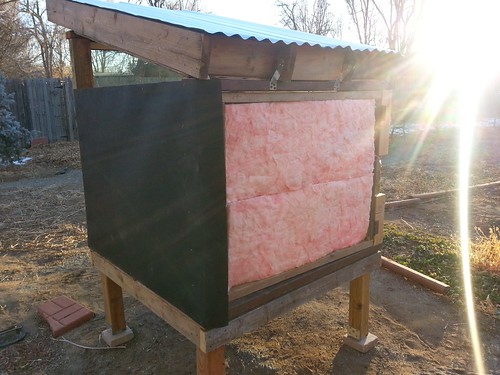
Eric spent the warmer days this past winter building our chicken coop. Isn't it beautiful? It is based on one of the simpler designs from Building Chicken Coops for Dummies. All of the lumber and sheathing is reclaimed wood from Craigslist free. The siding is reclaimed fencing from our back porch. The roof is corrugated metal. The walls, floor, and roof are all insulated (R-19 roof, R-13 walls and floor).

With insulated 2x4 walls, a 4' x 4' footprint only provided about 12 sf of chicken living area, but with the 48 sf run, this will be enough for 6 chickens. Construction was made easier because regular wall framing with 16" o.c. studs was not required.

Interior structural sheathing with plywood and OSB. No exterior sheathing (to save weight), just asphalt paper (found in the garage when we moved in) for a water and air barrier, and the cedar cladding on top of that (spaced out with 0.25" furring strips for a rain gap, of course).

R-19 cellulose insulation for the roof (2x6 rafters). This used a lot more insulation than I thought, since it didn't get passed through the cellulose blower machine to loosen it up. Next time I'd probably use fiberglass batts, but cellulose was convenient because the rafter spacing was not 14.5" so batts wouldn't fit without trimming.

Fiberglass batt wall insulation, covered with asphalt paper.

Finished coop, still lacking a run.
The window is a reclaimed triple pane from our local Habitat for Humanity store. Eric positioned it so that the roof overhang shades the window during the summer but allows plenty of sun during the winter. There is a wireless temperature sensor inside the coop so we get alerts to close or open up the ventilation areas (removable 1" foil-faced polyisocyanurate rigid foam triangles). The sensor was also used to monitor the heat lamp/temperature during the first 10 weeks when chicks need supplemental heat.

The 1/2" hardware cloth for the 4' x 12' run was the most expensive component! A nice side effect is that the mesh is closely spaced enough that snow piles on top so the chickens won't be snowed in. Half of the chicken run can be separated to be used as a chicken tractor.

The whole back wall swings open for easy access for cleaning.

As for the chicks, we got 2 Buff Orphingtons, 2 Ameraucanas, 1 Silver-Laced Wyandotte, and 1 Rhode Island Red. These chicks are already teenagers now. At four months old, they look pretty much look full grown. We expect they will start laying eggs when they are six months old which will be in October!



